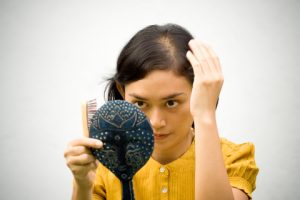 Hair loss is more often thought of as a male disease than female, but hair loss in women is a problem for about 40 percent of females, many of whom experience visible hair loss by age 40. Hair loss in women carries with it a devastating emotional toll that can directly affect physical health.
Hair loss is more often thought of as a male disease than female, but hair loss in women is a problem for about 40 percent of females, many of whom experience visible hair loss by age 40. Hair loss in women carries with it a devastating emotional toll that can directly affect physical health.
Measuring Women’s Hair Loss
The Savin scale is a common measure that ranges from normal hair density to a bald crown (very rare). It’s helpful in documenting female pattern baldness, which affects about 30 million American women. Experts think genetics and aging play a role in androgenic alopecia, along with the hormonal changes of menopause. Hair may become thin all over, with the greatest loss along the center of the scalp. A receding hairline is very rare in women.
Women tend to take more extreme measures than men do when it comes to finding a solution for their waning man, often resorting to home remedies that do very little. In an industry where both men and women spend into the billions for hair products that will grow or maintain their locks, the investment can get steep.
Rogaine and Minoxidil are two of the most popular products touted to spur hair growth and both are approved by the FDA; however, in most cases these products only help maintain existing hair rather than promote growth.
Hair restoration is more widely pursued by men, but for women in particular female hair loss categories, hair restoration is a safe, affordable option. If you are in one of the categories listed here, you are a good candidate for hair restoration.
- Women who have suffered hair loss due to mechanical or traction Alopecia (non- hormonal)
- Women who have had previous cosmetic or plastic surgery and are concerned about hair loss around the incision sites.
- Women who have a distinct pattern of baldness, similar to that of male pattern baldness. This includes hairline recession, vertex thinning, and a donor area that is not affected by androgenetic Alopecia.
- Women who suffer hair loss due to trauma, including burn victims, scarring from accidents and chemical burns.
- Women with alopecia marginalis, a condition that looks very similar to traction alopecia.
Whether female hair loss is the result of aging, hair damage, trauma, illness or genetics, the good news is there is a proven solution. It has swept the Dallas hair restoration market by storm and continues to turn out satisfied patients with beautiful, natural hair.
It’s called NeoGraft™. The product of 10 years of advanced research and development, the NeoGraft™ hair restoration program uses the most modern FUE (follicular unit extraction) method. NeoGraft involves no incisions, no cutting of the scalp, suturing or visible scarring.
Dallas NeoGraft experts have placed over two million grafts using the patented NeoGraft system, decreasing the time by 50 percent from standard female hair loss treatments.
Always ask for the physician’s credentials, how many of these procedures they have performed and a portfolio of before and after photos of their actual patients.



